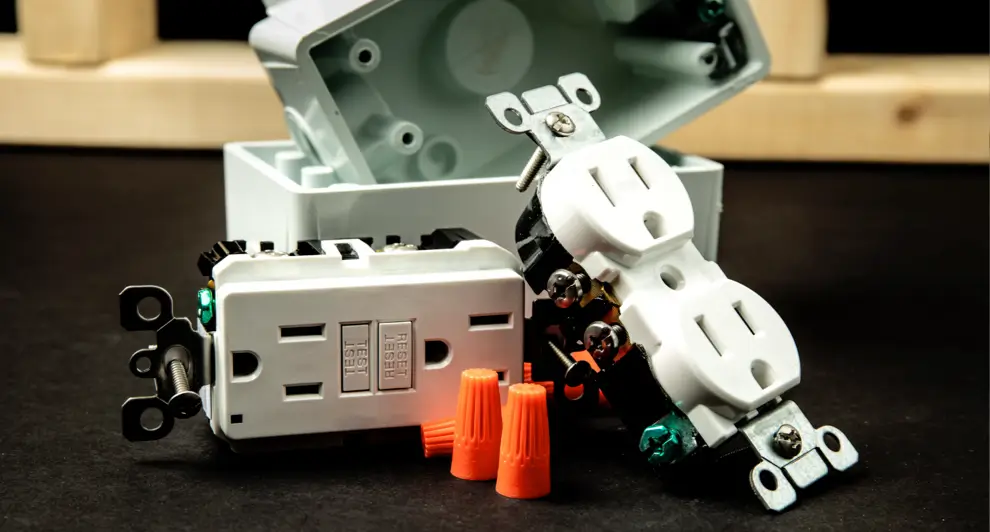
If you've ever stared at your outlet and wondered whether it's a GFI or GFCI—or if there's even a difference—you're not alone. The "GFI vs. GFCI" debate trips up a lot of homeowners, especially when electrical work starts creeping into everyday conversations. These acronyms show up on outlet covers, panel labels, and inspection reports, but unless you've wired a house or two, the details might feel a little murky.
Let's clear that up. This guide breaks down the terminology, the function, and the real-world uses, so you're not just nodding along the next time it comes up.
What's the Difference Between a GFI and a GFCI?
Short answer? There isn't one. "GFI" stands for ground fault interrupter, and "GFCI" means ground fault circuit interrupter. It's the same technology—just two different ways of saying it. Most electricians use "GFCI," since that's the term you'll see in the National Electrical Code (NEC). "GFI" tends to pop up more in casual conversation, on product packaging, or even in some older homes.
So if you're Googling GFCI vs. GFI and wondering what the real difference is, don't overthink it. It's mostly a matter of wording, not function. Same device, same protection, just a few extra syllables.
So, Is It GFI or GFCI—What Should I Be Calling It?
If you're aiming for technical accuracy, GFCI is the way to go. That's the term electricians, inspectors, and building codes stick to. But in everyday use, GFI has stuck around—mostly because it's shorter and shows up on outlet labels and packaging. Some manufacturers even print "GFI" right on the faceplate. So, while GFI or GFCI might sound like a matter of choice, there's a bit of context behind it. You're not wrong for saying GFI, but if you want to sound like you know your way around a breaker panel, GFCI is the term to keep in your back pocket.
What Exactly Does a GFCI Outlet Do?
A GFCI outlet checks the flow of electricity and cuts power in a split second if it senses even a tiny imbalance, like electricity taking an unintended path through water. That's what makes it such a critical safety device in kitchens, bathrooms, and other wet areas. When comparing a GFI vs. GFCI outlet, remember: both offer the same life-saving protection—it's the same outlet doing the same job.
Here's what a GFCI outlet does behind the scenes:
- Detects ground faults (unexpected current paths).
- Interrupts power in milliseconds.
- Helps prevent electrical shock and fire.
- Keeps your home safer in moisture-prone areas.
Regular outlets don't do any of that. This one does it automatically, quietly, and quickly.

Where Are GFCI Outlets Required in a Home?
Anywhere there's water, there should be a GFCI outlet. That's not just advice—it's code. The NEC lays out specific areas where GFCIs are required, and updates over the years have added more spots to the list. If your home is older, it might not be fully up to code, but newer construction and remodels are expected to follow these standards.
GFCI outlets are typically required in:
- Bathrooms
- Kitchens (serving countertop areas)
- Laundry rooms
- Garages
- Basements
- Outdoors
- Crawl spaces
- Unfinished areas
Bottom line: If the area gets wet or damp, it's probably on the list. And if you're not sure your outlets are up to code, that's a good time to get them checked.
Are GFCI Breakers the Same Thing as GFCI Outlets?
They do the same job, but in different places. A GFCI outlet protects a specific point, usually one outlet and anything wired downstream from it. A GFCI breaker, on the other hand, protects an entire circuit from inside your electrical panel. Both cut power when they detect a ground fault, but they're built for different setups.
If you're comparing GFI vs. GFCI breaker options, here's the breakdown:
- GFCI outlet: Installs at the wall, protects specific areas.
- GFCI breaker: Installs in the panel, protects the whole circuit.
- Cost difference: Breakers are more expensive, but cover more ground.
- Use case: Breakers make sense for unfinished basements, garages, or outdoor circuits.
So, no, they're not the same, but they're on the same team.
How Do I Know if My GFCI Outlet Is Working?
GFCI outlets come with their own built-in test system, no tools required. You'll see two buttons on the face of the outlet: TEST and RESET. These aren't decorative. Pressing TEST simulates a ground fault, which should instantly cut power. Hitting RESET restores it. If nothing happens when you press TEST, or if the outlet doesn't reset afterward, it's not doing its job—and that's a problem.
Here's a quick checklist to see if your GFCI outlet is working:
- Press TEST: Power should shut off.
- Plug something in: It shouldn't work.
- Press RESET: Power should come back.
- Still not working? Time to replace it.
Manufacturers recommend testing once a month. It takes 10 seconds and could prevent a serious shock.
Can I Install a GFCI Outlet, or Should I Call an Electrician?
Technically? Yes, you can install a GFCI outlet yourself—if you're comfortable shutting off power at the breaker, identifying line and load wires, and wiring everything correctly. But if that sentence made your eyes glaze over, it's probably a good idea to contact a service professional.
GFCI outlets need to be installed right to work properly and meet code. A backward connection can leave downstream outlets unprotected or create a constant tripping headache.
Bottom line: If you're confident with electrical work, go for it. If not, Mr. Electric® is happy to take that off your plate. We're skilled at installing and replacing outlets and circuit breakers.
Need Help Sorting Out the GFI vs. GFCI Confusion? Let Mr. Electric Handle It
Whether you're upgrading outlets, troubleshooting tripping issues, or wondering if your home's protection is up to code, our electricians can take it from here. We've seen every version of the GFI vs. GFCI conversation, and we know how to wire things right the first time. Plus, we back all our work with the Neighborly Done Right Promise®. Contact Mr. Electric today to schedule your GFCI installation, inspection, or replacement.
This article is intended for general guidance only and is not applicable to every situation. You are responsible for determining the proper course of action for your property and situation. Mr. Electric is not responsible for any damages that occur as a result of advice and/or guidance derived from its blog content.
Some Mr. Electric services vary by location. Contact your local Mr. Electric franchise for more information.

